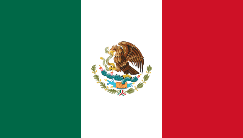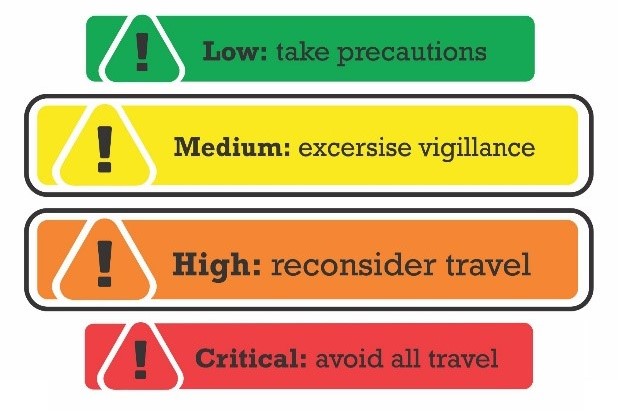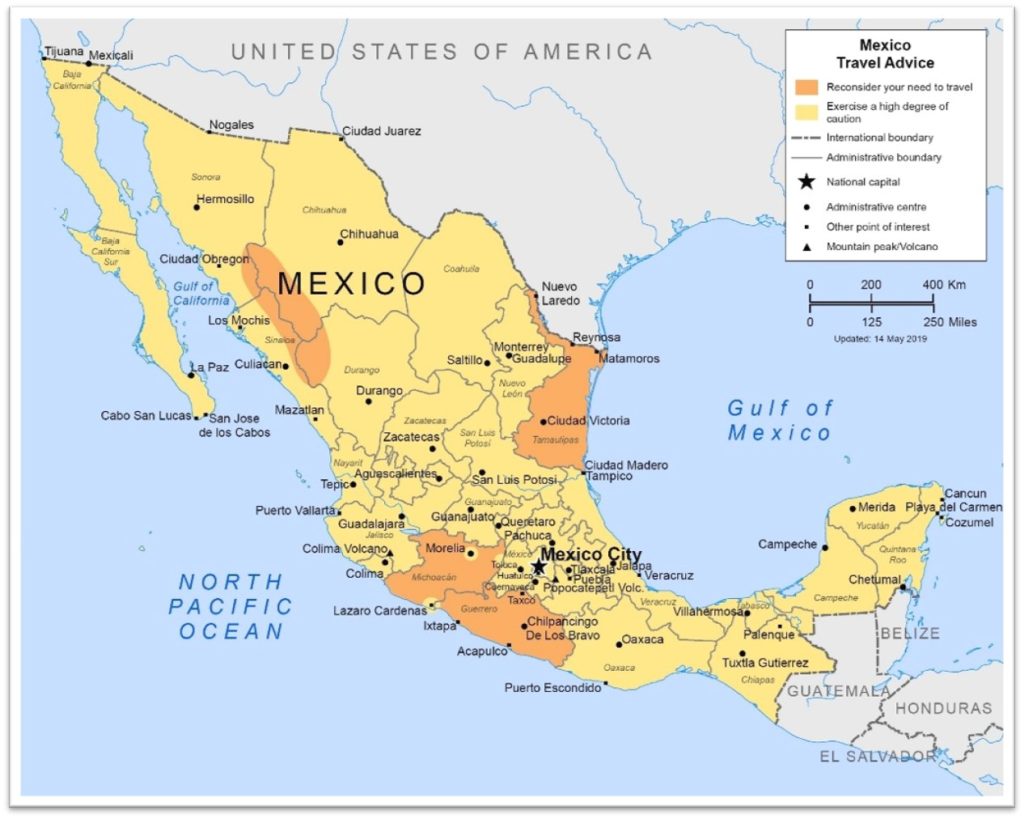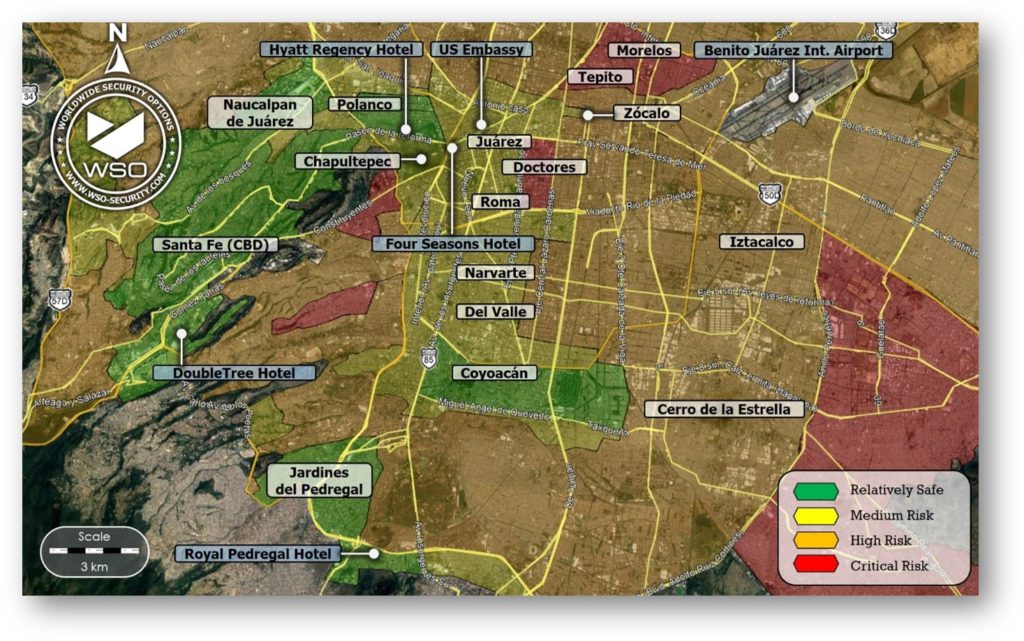| Official Name: | United Mexican States |
| Official Language: | Spanish |
| Area: | 1,972,550 km2 (761,610 sq mi) |
| Population: | 128,650,000 |
| Time Zone: | UTC−5/-6/-7/-8 |
| Capital City: | Mexico City (CDMX) |
| Elevation (CDMX): | 2,240m (7,350 ft) |
| Currency: | Mexican Peso (MXN) |
| Main Cities: Main Port: | CDMX, Guadalajara, Puebla, Monterrey Port of Veracruz |
| Required visa for entry: | Nationals from Canada, EU countries, and the UK and others DO NOT require visas. Click here for more information concerning visa requirements. |
| Required vaccination for entry: | None. |

Main Risks:
Theft, robbery, kidnapping, extortion, rape, drug and human trafficking, fraud, vehicle assault.
Executive Summary
Mexico features medium and high risks. Due to surmounting levels of criminal-related violence, as a rule of thumb, it is best to procure secure transportation services before traveling to the larger metropolitan and urban areas, including Mexico City (CDMX). While these are highly convenient, for tourist trips limited to Quintana Roo or Baja California Sur these are not necessarily required. In any case, for high-profile trips, we recommend procuring executive protection services. Notwithstanding the purpose of travel, given the considerable risks posed by crime, it is key to exercise vigilance and stay alert at all times.

General Risk Level: MEDIUM and HIGH
The risk generally depends on the given location. Avoid non-essential trips (recreational) to the following states: Guerrero, Michoacán, Tamaulipas. Avoid remote locales in Chihuahua, Sonora, and Sinaloa, especially if secure transportation services are unavailable. Moreover, refrain from traveling through peripheral or impoverished high and critical-risk areas within urban areas. Due to mounting violence in the country, it is necessary to study a security plan before traveling to Mexico, preferably under the supervision of reputable professionals.

Crime and Security
Mexico features high levels of violence and homicide stemming from criminal organizations, which commonly operate throughout the country. Cartels have long constituted the foremost threat to national security. The rivalry between opposing groups struggling for influence and territory often lead to gunfights and clashes in both rural and urban areas. It is generally understood that cartels like the Jalisco Nueva Generación (CJNG), Sinaloa, Golfo, and Zetas have heavy weaponry and advanced equipment, as well as illegitimate ties with corrupt governing officials and security elements. The main focal points for cartel violence are usually located in the western regions of the country, including the northern states of Baja California, Chihuahua, and Sinaloa. The northeastern state of Tamaulipas is also vulnerable to organized crime, especially along the corridor between Reynosa and Matamoros. Central parts of the country, and the western states of Guerrero and Michoacán in particular, are also prone to extended violence due to cartel operations. These states engulf the so-called “Tierra Caliente” (Hot Land), a region known for its desert-like conditions, poor human development, and the overall lack of effective state control. As a result, the region is dominated by organized crime elements. Cartels are also present on the east coast.
Given the risks posed by cartels, non-essential travel (tourist or recreational) to the abovementioned states should be avoided, especially if reputable secure transportation services and security advisories are unavailable. While the presence of armed groups is more acute in rural and sparsely populated areas, such elements are known to carry out operations in cities. In some instances, gangs travel through federal routes. Due to the circumstances, if travel to risk areas is required, stringent security precautions should be followed at all times.
Notwithstanding the challenges posed by organized crime, the main threat to those visiting Mexico remains opportunistic low and medium level crime. Criminals are frequently armed and they commonly operate in central or relatively safe areas in the larger cities. Leaving aside the risk of theft and pickpocketing, many criminals travel on motorbikes to promptly flee the scene after assaulting distracted pedestrians and drivers caught at a traffic standstill. In this sense, please bear in mind that traffic jams, above all in CDMX, pose a considerable security threat, especially within high and critical-risk neighborhoods (locally known as “colonias”). At any rate, visitors should exercise vigilance and stay alert at all times. Although most crimes transpire at random and foreigners are not necessarily targeted as such, victims are usually chosen based on appearances and perceptions of wealth.
While traveling through urban areas it is paramount to keep abreast of the local security situation in each district. If security advisories are unavailable, follow common-sense guidelines. For instance, avoid impoverished areas, especially those removed from the commercial districts and avenues. That said, notwithstanding changing security conditions in different sectors, due to overall criminal activity, it is best to avoid traveling during dark hours, especially on foot. Even the most privileged sites can witness violent incidents.
The security situation is usually far better within the large hotel complexes used by large numbers of foreign tourists, including the resorts of Quintana Roo and Baja California. Owing to the economic importance of tourism, these areas generally benefit from heightened security presence.
Security in CDMX
Street and opportunistic crime represent the biggest threat to those visiting the Mexican capital. Even central and privileged districts are vulnerable to high criminal activity. This is the case in areas frequented by foreigners and businessmen, such as the historic center and the Zócalo (Constitución Square), and the following colonias: Doctores, Roma, Narvarte, Del Valle, and Juárez, including the Zona Rosa (“Pink Zone”) featuring popular bars and restaurants. Although these neighborhoods are populated by the middle classes and play an important role in the city economy, they are still largely considered risk areas due to surmounting street crime. A similar situation transpires along Paseo de la Reforma, the most emblematic avenue in CDMX. The Chapultepec Forest is relatively safe, but risks in its surroundings increase considerably at night. The Polanco neighborhood (including Polanco Reforma and Polanco Chapultepec) is a notable exception. Owing to foreign embassies, luxury shops, and businesses, this area is better guarded by police and private security elements. Among the central areas in CDMX, Polanco is the best option to lodge and to carry out business transactions.
The north of Coyoacán, of greater tourist value, is also considered relatively safe, but the area is farther away from the largest commercial districts. 14
From a security standpoint, it is also feasible to stay and carry out transactions in the Santa Fe area, west of CDMX proper. Over the last decades, Santa Fe has gained a reputation as a central business district (CBD). Travelers can find business and high-level residential towers in the area. It is also possible to stay in Jardines del Pedregal in the south. However, bear in mind that the latter is chiefly residential.

CDMX features the busiest airport in Latin America. The Benito Juárez International Airport (MEX) is located northeast of the city, approximately 8 kilometers away from the Zócalo. However, given that traffic jams throughout the city are commonplace, travel to/from MEX can last between one and two hours depending on the time of departure and the starting point/destination in the city. As a rule of thumb, it is best to avoid the rush hours, particularly between 06:00 and 09:00, and from 17:00 to 22:00. At any rate, make sure to leave early to anticipate potential traffic disruptions. Moreover, for security reasons, avoid routes other than major thoroughfares or avenues.
Before traveling by car through CDMX, plan the route before taking to the streets, to avoid unnecessary detours or secondary routes which could potentially go through dangerous areas. Finally, please consider that due to pollution and traffic concerns, city authorities regularly apply travel restrictions to certain private vehicles. If these are to be used, as a precaution, ask locals for updated or relevant information.
Transportation
For security reasons, public transportation should be avoided unless the user is familiarized with the given network and the city in question. Public buses in Mexico are generally packed and exposed to pickpocketers. If possible, for all itineraries resort to reputable secure transportation services, especially for business and high-profile related-visits. Taxis may be used provided they are recommended by the largest hotels, and preferably booked in advance. Please note that in Mexico there are informal taxi networks that pose grave security risks to passengers, as these might be driven by unlicensed individuals or criminals looking to temporarily kidnap victims to extract their valuables. In any case, some taxi drivers might attempt to take advantage of foreign passengers to inflate the price of the trip. It is best to use ride-sharing apps before stoping a regular taxi on the streets.
From a security perspective, to travel within Mexico it is always far convenient and safer to travel by plane, avoiding land routes whenever possible. Although federal highways are generally in good condition, this is not necessarily the case for secondary and rural routes, which could potentially present heightened security risks. For example, this can be the case while traveling during dark hours or under poor visibility. Therefore, if travel by land is required, do not deviate from primary thoroughfares and highways. It should also be noted that armed groups sometimes operate along routes, chiefly within the aforementioned states in Western parts of the country. Occasionally, cartels mount roadblocks and shoot at frightened drivers who fail to stop their vehicles. Security forces are also liable to mount checkpoints, especially following upticks in cartel violence in a given area. In any event, if the itinerary involves traveling through the countryside, it is essential to reach out to reputable security professionals for advice and consultancy.
Health and Sanitary Conditions
It is recommended to vaccinate against yellow fever, tetanus, hepatitis A and B, and typhoid. The quality of tap water in Mexico is generally good. However, this might not be the case in remote or rural areas. As a precaution, it is therefore recommended to drink sealed bottled water while visiting or staying in such areas. If prolonged travel through northern states is required, where temperatures are usually higher, make sure to carry enough water. On another note, avoid leaving body areas uncovered to mitigate the risk of suffering mosquito-borne diseases such as Dengue fever, especially in western states and in shoreline areas.
It is not advised to travel without international health insurance covering emergency medical evacuation to the country of origin.
Take essential health precautions to mitigate the risk of contracting diseases or viruses. Carry masks in crowded places such as airports and maintain rules of social distance and avoid contact with surfaces of common use in public places. Always carry hand sanitizer.
Tactical Recommendations
Exercise vigilance and situational awareness throughout the trip to Mexico.
We recommend procuring private transportation services for all travel purposes to the larger cities, but especially for business and high-profile itineraries. For the latter, consider adding executive protection services. If private transportation is unavailable, use taxis vetted by the main hotels or ride-sharing apps. Avoid public transportation if not sufficiently familiarized with the city.
Avoid non-essential travel to the Guerrero, Michoacán, and Tamaulipas states if private secure transportation services are unavailable. Likewise, avoid travel to remote locales in Chihuahua, Sonora, and Sinaloa. As a rule of thumb, refrain from traveling through relatively remote and sparsely populated areas. In urban areas avoid peripheral and impoverished districts. Furthermore, keep abreast that even the relatively safe neighborhoods are prone to witnessing violent episodes.
If possible, travel to different destinations in Mexico by air. If travel via land routes takes place, avoid secondary routes and detours that could potentially lead to risk areas. If possible, plan the path and stopovers ahead under the supervision of reputable local security professionals.
Avoid carrying large sums of cash or valuables during the trip. We advise against wearing or carrying items in public that may give the impression of economic affluence and which could attract unwanted attention from criminals.
Avoid traveling in sport or luxurious cars which could attract unwanted attention from criminals.
Do not resist armed robbery attempts. We recommend to always carry a few 500 MXN bills for duress cases, specifically to appease criminals looking for easy money.
For security reasons, minimize travel during night hours, especially beyond the main commercial and residential areas. Avoid public spaces such as parks and beaches during the dark hours.
We recommend lodging in reputable establishments and hotels with private security. In CDMX it is best to stay in Polanco and Santa Fe. If possible, for security reasons, while traveling by car avoid the rush hours.
Avoid the vicinity of every kind of political demonstration or rally in urban areas. Peaceful protests can be infiltrated by violent elements.
Take all necessary precautions to mitigate the risk posed by mosquito-borne diseases. When visiting remote locations drink sealed bottles if the quality of tap water is questionable.
Emergency Contacts
Police: 123
Ambulance: 123
Fire: 123
WSO Global Command Center: +1 956 467 4858 / gcc@wso-security.com
Security advice and assistance over WhatsApp: +593 99 461 1128 / +521 81 1511 3166







